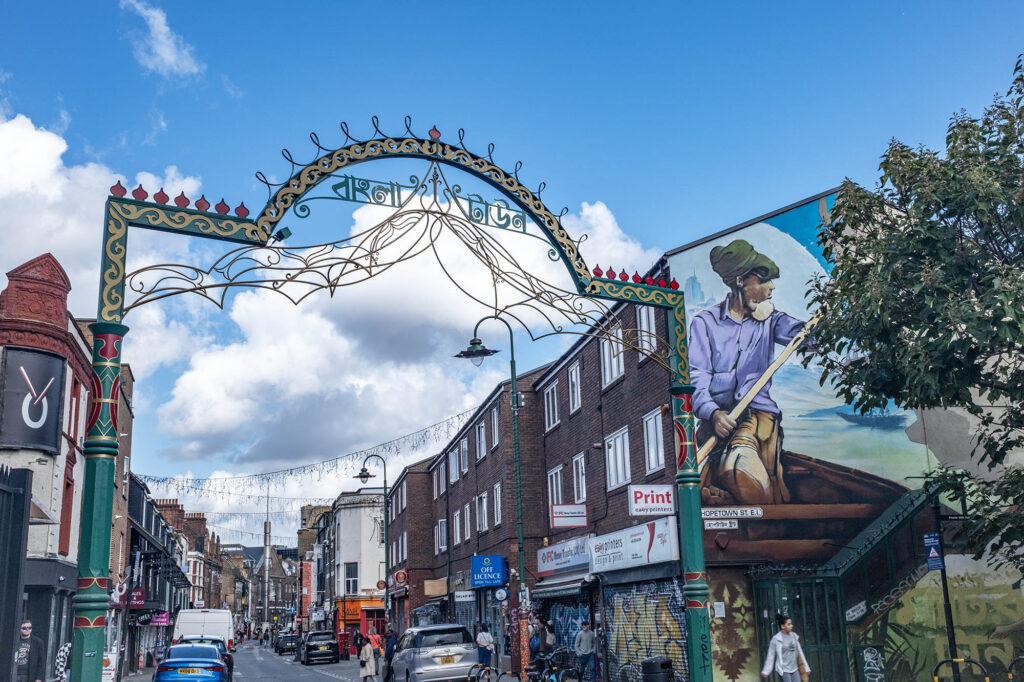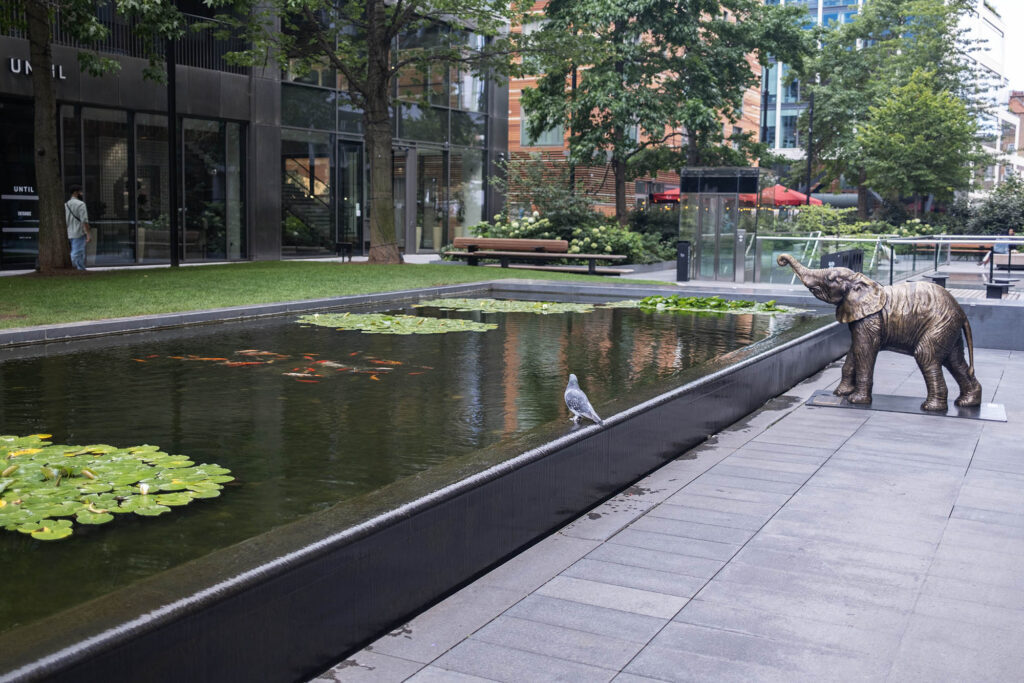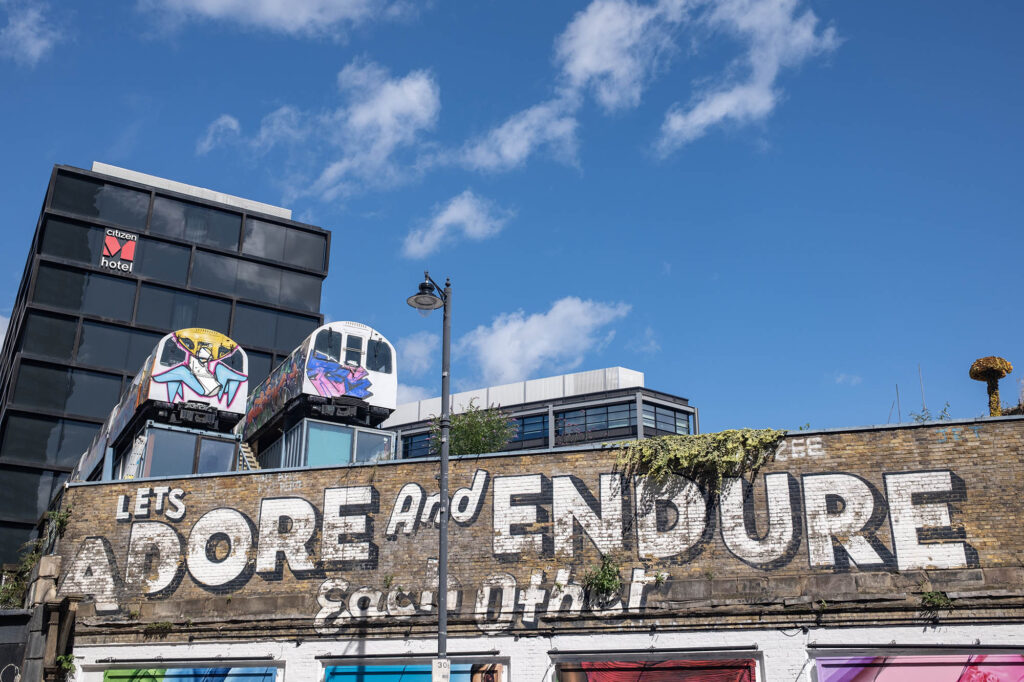Shoreditch and Spitalfields are two East London neighborhoods with a rich and fascinating history. Once home to immigrant communities, working-class residents, and bohemian artists, these areas have transformed over the centuries, reflecting the evolving social and cultural landscape of the city. Now, these are regarded as fashionable, young and vibrant areas to live and work. This self-guided walking tour of Shoreditch and Spitalfields will take you on a child-friendly walk that takes in the spirit of these areas whilst mixing in a bit of local life and a little playground or two.
History
Spitalfields has its roots in the 13th century, when the Priory of St. Mary Spital was founded, establishing the area as a center of healthcare and charity. In the 17th and 18th centuries, waves of Huguenot and Jewish immigrants settled in Spitalfields, bringing with them vibrant textile and weaving industries. The neighborhood’s historic market, dating back to 1682, became a hub of commerce and cultural exchange.
Shoreditch, meanwhile, has long been associated with the arts, dating back to the 16th century when it was home to the first purpose-built theatres in London, including the iconic Curtain Theatre. In the Victorian era, the area was known for its music halls, pubs, and the emerging textile trade. More recently, Shoreditch has undergone a renaissance, becoming a magnet for creative industries, tech startups, and a thriving street art scene.
Walk summary
Starting point: Aldgate East Station
End point: Liverpool Street Station
Duration: The walk is around 4km and the walk itself should take around an hour. On top of this you should allow time to see the various sights en route. If you decide to undertake any of the side quests (i.e. something optional that you could choose to see that is on or nearby the walking route), allow additional time.
London sights you will see along the way: Brick Lane, Old Spitalfields Market, street art and Boxpark Shoreditch
Side quests: Whitechapel Gallery
The route
Part 1 – Aldgate East Station to Old Spitalfields Market

Your starting point is Aldgate East Station Exit 2 Toynbee Hall Exit, with the station exit behind you, turn left.
SIDE QUEST: If your child loves football, the shop Classic Football Shirts is just a few minutes up Commercial Street to your left.
Cross the road in front of you and continue straight on until you get to the next left turn – Osborn Street.
SIDE QUEST: Before you get to Osborn Street you should pass by the Whitechapel Gallery on your left. Whilst not the most child-centred of London galleries, it is free to visit and may be worth a visit or a quick look in, depending on what is on.
Turn up Osborn Street and keep going straight on. At the first junction, Osborn Street turns into Brick Lane.
Brick Lane takes its name from the manufacture of bricks which took place starting in the 15th century using local brick earth. It evolved into a hub for waves of immigrants. In the 17th and 18th centuries, French Huguenots settled in the area, establishing a thriving silk-weaving industry. The 19th century saw an influx of Jewish immigrants, transforming Brick Lane into a center of Jewish culture and commerce. In the latter half of the 20th century, Bangladeshi immigrants began to settle in the neighborhood, giving rise to its current reputation as London’s ‘Curry Mile’. Today, Brick Lane is known for its vibrant street art, vintage markets, and eclectic mix of cultures, reflecting its long history as a melting pot of different communities.

Keep walking straight on until you see Fashion Street on your left. There are usually some great pieces of street art on Fashion Street so if that’s something you’re particularly interested in, have a walk down Fashion Street and back.

Keep walking up Brick Lane, passing a school with blue gates on your left. Just past the school you’ll see a private road between two buildings which leads into a small enclosed yard – Seven Stars Yard. This is a great place to see street art.

Once you’ve see what’s there, head back onto Brick Lane. Take the next left onto Fournier Street.
Walk down Fournier Street. You will notice that the houses here are quite grand. Developed in the 1720s, Fournier Street was originally named Church Street due to its proximity to Christ Church Spitalfields. The street was designed to house wealthy Huguenot silk weavers who had fled religious persecution in France. These skilled craftsmen built elegant Georgian townhouses, featuring distinctive large attic windows that provided ample light for weaving.
At the end of Fournier Street, you’ll see Old Spitalfields Market across the road. Cross the road.
Spitalfields Market’s name derives from the hospital and priory, St. Mary’s Spittel, that once stood nearby. Originally an informal gathering of market traders, it evolved into a significant wholesale fruit and vegetable market by the 17th century. The iconic market building, designed by George Sherrin, was erected in 1887 to house the expanding trade. Spitalfields thrived as London’s primary produce market for centuries, but faced decline in the 1980s when many traders relocated to the New Spitalfields Market in Leyton. This prompted a regeneration effort, transforming the historic site into the vibrant retail and cultural destination that exists today where fruit and vegetable stalls have given way to clothes, crafts, and street food stalls.

Spend some time exploring the offerings of Spitalfields Market and its surrounds. The shops and stalls are an excellent place to buy a souvenir of your trip to London. The street food stalls at the centre of the market and around its edges are an excellent place to buy lunch or a snack. Whether you fancy pizza, pasta, a burger or something more unusual, like Ethiopian or Nigerian food, you’ll find it all at Spitalfields Market.

Make sure you spend some time exploring the area around Spitalfields Market. Look out for public art pieces, like the Herd of Hope elephant statues.
If you need a bit of time to chill, the Bishops Square area just to the West of the market offers a bit of respite. There are patches of grass, benches and even a fish pond. This area is also a great place to bring any food you buy from the market.

Part 2 – Old Spitalfields Market to Hanbury Street
Leave Spitalfields Market and head back to the crossing you took when arriving from Fournier Street. Cross the road and instead of heading down Fournier Street, turn left. Walk straight on until you come to the first right turn onto Hanbury Street.
Walk down Hanbury Street. At the junction with Brick Lane, cross the road (NB. If you’re following the map, you don’t need to do the u-turn south, a quirk in the maps function seems to add this when plotting). This next section of Hanbury Street is usually home to some fantastic street art, including a large scale heron by Roa. If you’re interested in street art, it’s worth walking down Hanbury Street to the end of the street as there are often some nice large-scale murals at the end.

Once you’ve seen the street art here, head back to the junction with Brick Lane.
Part 3 – Hanbury Street to Spitalfields City Farm
Walk North up Brick Lane, checking out the street art as you go. Keep going until you see Buxton Street on your right. Turn onto Buxton Street and keep walking until you reach Spitalfields City Farm on your left. Just before you get there, there is some play equipment in the park if you have younger kids.

Spitalfields City Farm offers a delightful rural oasis in the heart of urban East London, making it a perfect stop for families exploring the area with children. Established in 1978 on a former railway goods depot, this community-run farm provides a hands-on experience with a variety of farm animals, including donkeys, goats, sheep, rabbits, and chickens. The farm also features areas where children can see vegetables growing. The farm has a number of small areas to sit and have a little break and a bit of respite from the city. It’s also a good place to have a toilet stop if you need it en route! Train lovers will also get to see the Overground passing next to the farm.

Part 4 – Spitalfields City Farm to Boxpark
Leave the farm via the Buxton Street entrance and turn right. Take the footpath on the right into the park and follow it through the park. Along the way you will see street art on the walls of the Overground tracks. Keep the railway track on your right as you go.

When you reach the edge of the park, keep to the right hand side. Walk straight ahead, taking the path between the buildings.
Make sure to take some time to appreciate the street art here. There are usually some fantastic pieces and a number of large scale murals. You may even see street art being created.
Keep walking straight ahead and you’ll find that you’ve rejoined Brick Lane.

Turn right and keep walking North up Brick Lane.
You will pass a variety of shops, cafes, restaurants and galleries, which may be of interest. You will also pass under a railway bridge on which you can see a Banksy – three monkeys swinging.

At the top of the road, turn left.
Keeping to the left, walk straight ahead keep going until you reach your next stop, Boxpark Shoreditch. This will be on your left.

Boxpark Shoreditch, a pop-up mall constructed entirely from refitted shipping containers, opened in 2011. This distinctive urban space houses a variety of trendy boutiques, quirky gift shops, and diverse food vendors. This is an ideal place to stop for a bit of shopping, a snack or perhaps a dessert.

Part 5 – Boxpark to a secret garden
With Boxpark and the railway bridge on your left, cross to the other side of the road and then across the other road (so you end up diagonally across from the corner of Boxpark). You are looking for a one-way street called Holywell Lane.
Walk down Holywell Lane, looking out for street art, until you reach King John Court on your right. The buildings here are home to a number of large-scale murals. Walk down the street.
At the bottom of King John Court, bear left and walk to the end of the road. At the end of the road, bear round left onto Great Eastern Street (essentially you’ve sort of looped the block).
Keep walking down Great Eastern Street and when you get the chance, cross the road to the opposite pavement. Across the road you should see a large piece of street art and two old Jubilee Line train carriages.

Just across from the sign, you should see a tree lined avenue. If you head down this avenue you should see a set of stairs on the left. If you head up the stairs you will find a secret garden with a few pieces of play equipment.

Part 6 – Secret garden to Liverpool Street Station
From the secret garden, head back down the stairs, back to the main road across from the Adore and Endure sign. Turn right, head to the end of the road and turn right. Keep walking straight down and you’ll get to Liverpool Street Station on your right.
You’ve reached the end point of this walk!
From here you could enjoy the sights of the City of London or nearby Tower Hill.
Route
Have you done this walk and found somewhere cool along the way that others walking the route with kids should definitely see? Share in the comments!



3 comments
[…] Explore street art in Shoreditch and Spitalfields […]
[…] Taking art out of the galleries and into the public domain, street art appears throughout London but in Central London it is perhaps most concentrated in the East London neighbourhoods of Shoreditch and Spitalfields. A walk around these neighbourhoods will reveal an ever-changing outdoor gallery of street art, ranging from huge murals to tiny pasted pieces. For a tour that takes in the main spots for street art, try our self-guided walking tour of Shoreditch and Spitalfields. […]
[…] those looking to see street art in London, why not try our Shoreditch and Spitalfields with kids: self-guided walking tour which takes you to some of the best spots in East London? Alternatively, visit Leake Street […]